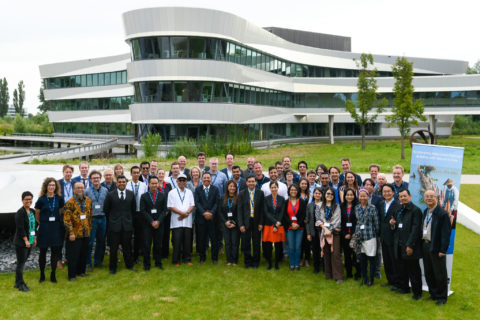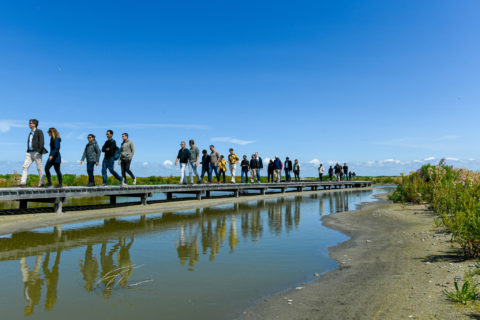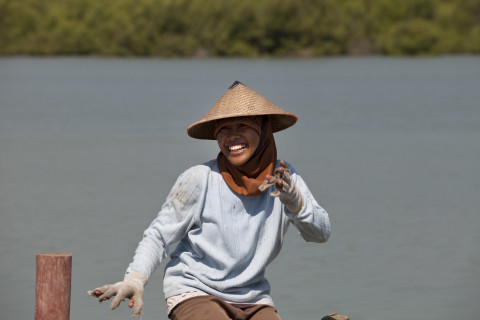
Asia rallies behind Building with Nature to scale up climate change adaptation efforts
-
Coastal resilience
-
Coastal wetland conservation
Indonesia, Malaysia, Philippines, Japan and India are among the countries gathering in the Netherlands this week to discuss how to scale up the nature-based adaptation measures needed to protect the region from a growing host of hazards including flooding, storm damage and coastal erosion. Convened by a group of international NGOs and organisations, including the Global Commission on Adaptation and Wetlands International, the aim is for policymakers and technical experts to work together towards a formal commitment that will tackle these mounting risks.
With more than 100 million people flood-exposed across cities including Jakarta, Bangkok and Manila in deltas and estuaries of the region[1], decision makers are faced with the complex challenge to maintain natural environmental defences and deliver socially beneficial, climate-resilient infrastructure.

Traditional solutions, such as dams, barriers and seawalls often have major negative impacts and disturb hydrological and sedimentary processes. Organisations such as EcoShape and Wetlands International are redirecting attention to alternative approaches such as ‘Building with Nature’, which integrates infrastructure design with the restoration of ecosystems that add value through coastal protection, flood regulation, as well as boosting fisheries, recreation and biodiversity.
Building with Nature involves an inclusive planning process comprising hydrologists, ecologists and engineers working jointly with local communities and government stakeholders to develop sustainable solutions that meet local needs.
Since 2012, the Indonesian Ministry of Marine Affairs and Fisheries has taken a lead and engaged with international organisations and local communities to halt coastal degradation and subsidence in Java using this approach. What started as a small experiment in one village has grown into a landscape-scale initiative along a 20 km coast and 13 districts, addressing disaster risk reduction, climate adaptation and community resilience. Examples such as these demonstrate that Building with Nature is effective in tackling a rising tide of hazards, yet wider uptake across Asia is still slow.

“Building with Nature represents a paradigm shift from minimising negative impacts to maximising positive benefits for society and nature. In many vulnerable settings it is the only possible way forward. With the growing threat of climate change and hazards from the loss of wetlands, it is vital we scale up these necessary adaptation measures as soon as possible,” said Jane Madgwick, Chief Executive Officer of Wetlands International, co-organiser of the week’s activities.
The Global Center on Adaptation is currently working with the Global Commission on Adaptation on the release of its flagship report ahead of the UN Climate Summit on 23 September 2019.
Patrick Verkooijen, Chief Executive Officer of the Global Center on Adaptation and Managing Partner of the Global Commission on Adaptation said: “Adaptation that works with nature has an enormous payoff, both in direct economic terms and in terms of less easily quantified social and economic benefits. Initiatives like Building with Nature that improve climate resilience must be widely adopted. In collaboration with our office in Beijing, I hope other countries in Asia will learn from Indonesia’s experiences to adopt and scale up existing adaptation solutions. No country can tackle this global challenge alone”.

Henk Nieboer, Director of EcoShape said: “At EcoShape we gathered a wealth of knowledge about designing and implementing Building with Nature solutions through a number of pilot projects, realised since 2008. We develop the design of each solution together with local stakeholders, based on a systematic analysis of the environment. We integrate economic, societal and environmental values in the design to create a viable and sustainable business case.”
Isao Endo, Environmental Specialist, Asian Development Bank said: “Investing in natural capital can help in receiving multiple benefits such as restoring critical ecosystems, improving climate and disaster resilience, and creating liveable cities. Development policies and plans must incorporate the value of natural capital and ecosystem services, as well as the social and environmental costs of losing them, into early project design and planning. Nature-based solutions with ecosystem and biodiversity-sensitive options should be part of a standard suite of investments to enhance environmental sustainability.”
Bregje van Wesenbeeck, Ecologist, Deltares added: “Current global threats such as climate change and biodiversity loss challenge us to rapidly re-invent the way we have been managing our coastlines and river systems. Inclusion of nature and biodiversity in infrastructure and urban development is part of the answer. Although nature-based solutions are surrounded with uncertainties and unknowns, we need to implement while gathering knowledge in parallel.”
